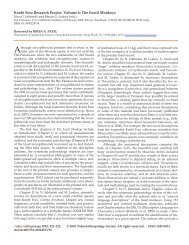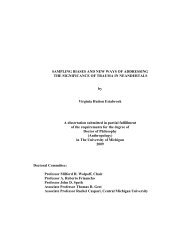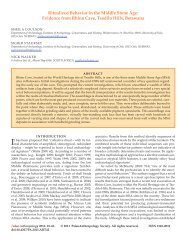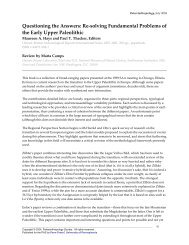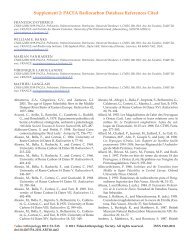PDF (12134 K) - Paleoanthropology Society
PDF (12134 K) - Paleoanthropology Society
PDF (12134 K) - Paleoanthropology Society
Create successful ePaper yourself
Turn your PDF publications into a flip-book with our unique Google optimized e-Paper software.
While some are immediately adequate for use, others are<br />
adapted after hafting, in some cases after a few test scrapes.<br />
For this further shaping, the stone tool is never taken out of<br />
its haft. Also, all resharpening takes place in the haft (Figure<br />
12). Fractures regularly occur during this process—of<br />
the scraper itself or of the resin that is used to fix the stone<br />
tool in a concavity of the wooden handle. In the latter case,<br />
the stone tool “falls” out of its haft. Fractures of the stone<br />
tool are at the haft limit, leaving the proximal part within<br />
the resin. As for the experimental examples, scarring is associated<br />
with the fracture edges. This fractured hafted part<br />
is removed from the resin with a metal tool after heating<br />
and softening the resin in the hot ashes of a fire.<br />
A SuMMARy of ThE LAnCEoLATE<br />
PoInT’S ChAînE oPéRAToIRE<br />
The lanceolate point from the upper level at Taramsa-8 entered<br />
the archaeological record after it had been broken in<br />
its haft while receiving its final shape. The associated initial<br />
production flakes, some of which were refitted onto the<br />
Analysis and Interpretation of a Lanceolate Point • 245<br />
Figure 10. Other types of experimental hafting wear: (a) polish; (b) bright spots; (c and d) striations.<br />
basal part of the point, and the presence of this assemblage<br />
within fill deposits of an extraction pit, evidence a long,<br />
complex, and yet uninterrupted chaîne opératoire for this<br />
tool.<br />
A particular chert pebble was selected and bifacially<br />
reduced in the immediate vicinity of the place where it had<br />
been retrieved from its natural deposit. Although there is<br />
no evidence for this, we assume that an existing haft was<br />
brought along, ready for this pre-form to be inserted. It is<br />
alternatively possible that the haft itself was produced at<br />
the same spot as well. In principle, the presence/absence<br />
of tools with particular use-wear traces would constitute<br />
evidence in this regard. Such tools have not been found,<br />
but the excavation was far too limited to attach any weight<br />
to this observation. There is simply no evidence about the<br />
chaîne opératoire for the haft itself.<br />
Next, the lithic point was fixed into the haft in a seemingly<br />
definitive manner, according to the evidence for bindings.<br />
We must, therefore, assume that the required technological<br />
means for hafting had been brought along as well.



